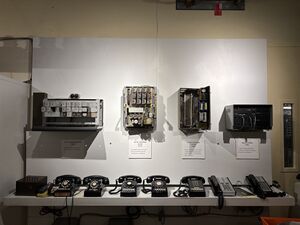CMS:Key System Collection

The Key System Collection contains several examples of key systems with accompanying phones
Collection
1A
1A1
With the introduction of the 1A1 Key Telephone System (KTS) in 1952, packaged systems were available to reduce the amount of time required to install key systems at the customer site. The example here is a second-generation packaged 1A1 KSU (Key Service Unit) from the mid-1950s. It includes the updated incoming line unit, a dial intercom selector, and the newly-introduced motor-driven interrupter (earlier 1A1 systems used a relay-driven interrupter that was mechanically very noisy). This is the smallest packaged system offered and includes capacity for up to four incoming CO (or PBX) lines.
The interrupter provides lamp signaling functions for each incoming line lamp: flash (for ringing) or wink (for a held line). When the line is answered, its associated line lamp remains lit until the call is dropped.
The telephone sets used with the 1A1 display are Western Electric 564 (rotary, with round line keys).
1A2
In 1964, Western Electric began production of the 1A2 system. This used printed-circuit cards (made from epoxy-coated steel), with miniature relays and solid-state components. These systems were easier to set up and maintain than older 1A1 systems. The example here is the smallest packaged 1A2 system, commonly known as a shoebox. It could supply power and switching logic for up to five individual telephones; each telephone has access to a maximum of four incoming telephone lines plus an intercom line. As with the later 1A1 systems, there is a motor-driven interrupter to provide lamp signaling for each incoming line.
The telephone sets used with the 1A2 display are Western Electric 565HK (rotary, with square line keys) and 2565HKM (tone dial).